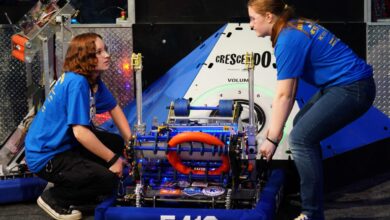Spiderlike Mars Robot Might One Day Crawl through Unexplored Volcanic Caves

Spiderlike Mars Robot Might One Day Crawl through Unexplored Volcanic Caves
This eight-legged probe would scour Mars’s underground lava tubes for places where explorers might camp—or for signs of past life
Field testing the ReachBot in a lava tube in the Mojave Desert.
A robot designed in the spiderlike image of a “daddy longlegs” may be on its way to help scientists explore the next frontier on Mars: caves. A partial prototype of the machine, called ReachBot, has demonstrated its ability to grasp the uneven walls of a natural cavern in California’s Mojave Desert, as described in a study published Wednesday in Science Robotics.
The tests show that ReachBot’s unique gripping mechanism and arachnid configuration may be useful for extraterrestrial spelunking. “If you really want to explore all over the inside of a [Martian] cave, ReachBot is going to be hard to beat,” says senior study author Mark Cutkosky, a mechanical engineering professor at Stanford University.
Six rovers have already successfully landed on Mars, but much of the planet remains unexplored—including its caves and lava tubes, underground corridors formed by molten rock. “The subsurface has never really been examined, other than seismic measurements and penetrating radar,” says Wolfgang Fink, an associate professor of engineering and Edward and Maria Keonijan Endowed Chair at the University of Arizona, who was not involved in the ReachBot research. Some astrobiologists think this extensive subterranean network could be the Martian locale most likely to harbor signatures of past or present alien life. Caves might also be potential sites for human habitation.
On supporting science journalism
If you’re enjoying this article, consider supporting our award-winning journalism by subscribing. By purchasing a subscription you are helping to ensure the future of impactful stories about the discoveries and ideas shaping our world today.
Navigating irregular, unmapped and descending terrain 140 million miles from Earth would clearly require some highly specialized equipment. Other robots proposed for Martian cave exploration include the caninelike, four-legged NeBula-SPOT and the Descent and Exploration in Deep Autonomy of Lava Underground Structures (DEADALUS) device, which would hang into a pit on a tether from a surface rig. A grasping machine such as ReachBot, Fink says, might offer a few advantages—such as the ability to access walls and ceiling areas beyond the reach of ground-based rovers or short-range flying drones. ReachBot’s strong limbs could also potentially drill core samples and execute other forceful tasks.
To build something that can traverse a large area and still be lightweight and maneuverable, Cutkosky and his colleagues found inspiration in arachnids—specifically, long-legged spider cousins called harvestmen, aka daddy longlegs. ReachBot has a small central body and up to eight appendages. Those limbs, or booms, can be rigid or rolled up, like a metal measuring tape. (In small-scale lab tests, the engineers used ordinary tape measures as stand-ins for the much more expensive carbon-fiber material that would be used in space.)
At the end of each boom is a three-fingered gripper equipped with “microspines,” made from sewing needles, that help the bot firmly grasp rough rock. These grippers stabilize the robot by maintaining uniform tension across each boom, a function Cutkosky likens to “spokes on a bicycle wheel.” Cameras and sensors on the central body and the grippers enable ReachBot to perceive its surroundings and choose where to place its mechanical hands. The slow-moving bot is designed to advance methodically by detaching and relocating one boom at a time, while the central body shifts position as booms extend and retract.
“From a pure robotics point of view, this is a really great idea,” Fink says. He has reservations, though, about how a robot as complex as ReachBot might hold up in a Martian cave, where a lot can go wrong and repairs are difficult. “One would almost prefer something simpler,” he says, pointing to the beach ball–esque Tumbleweed rover concept design from NASA’s Jet Propulsion Laboratory.
Minimizing fragility and managing the moving parts are ongoing concerns, Cutkosky says, but he notes that some protective redundancy is built into ReachBot; one or two damaged limbs would not prevent it from functioning. Michelle Rosen, an assistant professor of mechanical engineering at the Cooper Union for the Advancement of Science and Art and a robotics researcher uninvolved in the new study, also sees the value of eight appendages. “Redundancy like that is a really good thing, especially when you’re thinking about planetary exploration,” she says, adding that the proof-of-concept work was “super compelling.”
ReachBot’s three-fingered gripper firmly grasps handholds in cave walls.
In 2023 lead study author Tony Chen, a robotics expert at Stanford University, hiked through the Mojave Desert with some of his co-researchers to a lava tube chosen for its likely similarities to Martian caves. There they ran tests with a single-boom version of ReachBot mounted on a tripod to see how well it could identify grip points on the lava tube’s walls. The perception system “worked really well” to home in on suitable robot handholds, Chen says. And the bot’s boom and gripper mechanism performed as hoped, reaching for those points with a secure grip.
But one thing the team hadn’t planned for was the sheer volume of magnetic dust present inside the lava tube. The ferrous crud didn’t disable ReachBot during three days of testing, but “so much dust accumulated inside the robot” that this may pose a longer-term problem, Chen notes. Future designs will have to deal with such intrusions, especially if a machine like ReachBot is destined for a distant, dusty world. “We’re still quite far away from actually being on Mars,” Chen says. It’s one small grasp for a robot prototype on Earth, hinting at a leap in our knowledge of what lies beneath other planets.



